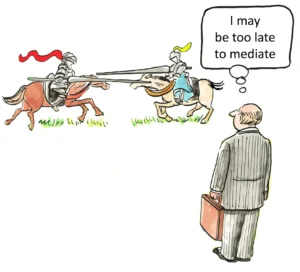The hard look doctrine’s role in arbitrary and capricious determinations
The hard look doctrine plays a crucial role in shaping how courts apply the arbitrary and capricious standard when reviewing agency actions under the Administrative Procedure Act (APA). This doctrine, which emerged from a series of landmark court decisions, requires agencies to engage in thorough and reasoned decision-making processes when formulating rules or taking other significant actions. By mandating a more rigorous review of agency decisions, the hard look doctrine serves as a vital check on administrative power and helps ensure that agency actions are based on sound reasoning and consideration of relevant factors.
At its core, the hard look doctrine requires courts to take a searching and careful inquiry into the agency’s decision-making process when applying the arbitrary and capricious standard. This approach goes beyond a mere surface-level examination of the agency’s stated rationale and instead delves deeper into the underlying reasoning and evidence supporting the agency’s action. The doctrine emerged as a response to concerns that agencies were not always providing sufficiently thorough explanations for their decisions or considering all relevant factors in their decision-making processes.
One of the seminal cases in the development of the hard look doctrine is Motor Vehicle Manufacturers Association v. State Farm Mutual Automobile Insurance Co., decided by the Supreme Court in 1983. In this case, the Court articulated a more demanding standard for agency decision-making, emphasizing that agencies must provide a “reasoned analysis” for their actions and consider all relevant factors. The Court stated that an agency rule would be considered arbitrary and capricious if the agency has relied on factors which Congress has not intended it to consider, entirely failed to consider an important aspect of the problem, offered an explanation for its decision that runs counter to the evidence before the agency, or is so implausible that it could not be ascribed to a difference in view or the product of agency expertise.
The State Farm decision set the stage for a more rigorous application of the arbitrary and capricious standard, requiring agencies to demonstrate that they have engaged in a thorough and rational decision-making process. This approach has had far-reaching implications for administrative law, influencing how agencies approach rulemaking and how courts review agency actions across a wide range of policy areas.
One key aspect of the hard look doctrine is its emphasis on the agency’s consideration of relevant factors. Courts applying this doctrine will scrutinize whether the agency has taken into account all important aspects of the problem it is addressing. This requirement ensures that agencies do not overlook critical issues or ignore significant evidence that might contradict their preferred course of action. For example, in a case involving environmental regulations, a court might examine whether the agency adequately considered scientific data on the potential impacts of pollution, economic analyses of compliance costs, and public health studies, among other relevant factors.
The hard look doctrine also requires agencies to provide a clear and logical explanation for their decisions. This means that agencies must articulate the reasoning behind their actions in a way that allows courts to understand and evaluate the decision-making process. Merely stating a conclusion or offering a cursory explanation is not sufficient under the hard look standard. Instead, agencies must demonstrate a rational connection between the facts found and the choice made, providing a detailed justification for their actions that addresses any significant criticisms or alternative approaches raised during the decision-making process.
Another important aspect of the hard look doctrine is its focus on the agency’s response to public comments and criticisms. When agencies engage in rulemaking, they typically solicit public input through a notice and comment process. The hard look doctrine requires agencies to seriously consider and respond to significant comments received during this process. This requirement serves to ensure that agencies engage meaningfully with stakeholder input and do not simply ignore relevant information or perspectives that are brought to their attention.
The application of the hard look doctrine has had significant implications for how agencies approach the rulemaking process. Knowing that their decisions will be subject to searching judicial review, agencies have been incentivized to develop more comprehensive administrative records, conduct more thorough analyses, and provide more detailed explanations for their actions. This has led to more transparent and accountable agency decision-making, as agencies strive to demonstrate that they have considered all relevant factors and engaged in reasoned decision-making.
However, the hard look doctrine has also been the subject of criticism and debate. Some argue that it imposes too heavy a burden on agencies, potentially leading to regulatory paralysis as agencies become overly cautious in their decision-making. Critics contend that the doctrine may encourage agencies to produce voluminous records and lengthy explanations that do not necessarily improve the quality of decision-making but do increase the costs and time associated with rulemaking.
Others argue that the hard look doctrine gives too much power to courts, allowing them to substitute their judgment for that of agency experts. This concern is particularly acute in cases involving complex scientific or technical issues, where courts may lack the specialized knowledge to fully evaluate the agency’s reasoning. Critics worry that overzealous application of the hard look doctrine could lead to courts second-guessing agency decisions on matters that are better left to expert judgment.
Despite these criticisms, the hard look doctrine remains a fundamental principle in administrative law, shaping how courts apply the arbitrary and capricious standard. Its influence can be seen in numerous court decisions across various policy areas, from environmental regulation to financial oversight to public health and safety measures.
One area where the hard look doctrine has had a particularly significant impact is in environmental law. In cases involving environmental regulations, courts have often applied a rigorous form of hard look review, scrutinizing agency decisions for compliance with environmental statutes and demanding thorough consideration of scientific evidence and potential environmental impacts. For example, in cases involving the Environmental Protection Agency’s (EPA) implementation of the Clean Air Act or Clean Water Act, courts have closely examined whether the agency has adequately considered relevant scientific studies, addressed potential environmental consequences, and provided a reasoned explanation for its chosen regulatory approach.
The hard look doctrine has also played a crucial role in shaping judicial review of agency actions in the realm of financial regulation. In the wake of the 2008 financial crisis, courts have applied hard look review to scrutinize the actions of financial regulatory agencies such as the Securities and Exchange Commission (SEC) and the Commodity Futures Trading Commission (CFTC). These cases often involve complex economic analyses and predictions about market behavior, requiring courts to carefully evaluate whether agencies have adequately considered relevant economic factors and provided a reasoned explanation for their regulatory choices.
Another area where the hard look doctrine has had significant influence is in cases involving public health and safety regulations. Courts have applied hard look review to agency decisions on issues ranging from food safety standards to workplace health regulations to drug approvals. In these cases, courts often examine whether agencies have adequately considered scientific evidence, potential risks and benefits, and alternative regulatory approaches. The hard look doctrine has been particularly important in ensuring that agencies provide thorough justifications for decisions that may have significant impacts on public health and safety.
The application of the hard look doctrine in the context of emerging technologies and artificial intelligence is an area of growing importance. As agencies grapple with regulating new technologies that may have far-reaching societal impacts, courts are likely to apply hard look review to ensure that agencies have adequately considered the complex technical and ethical issues involved. This may include scrutinizing whether agencies have considered potential risks and benefits, engaged with relevant stakeholders, and provided a reasoned explanation for their regulatory approach to these rapidly evolving technologies.
The hard look doctrine also intersects with important principles of administrative law, such as the Chevron doctrine of judicial deference to agency interpretations of statutes. While Chevron deference generally requires courts to defer to reasonable agency interpretations of ambiguous statutes, the hard look doctrine ensures that agencies must still provide a reasoned explanation for their interpretations and consider all relevant factors. This interplay between deference and hard look review creates a nuanced framework for judicial oversight of agency actions, balancing respect for agency expertise with the need for thorough and reasoned decision-making.
The application of the hard look doctrine in cases involving agency policy changes is another important area of administrative law. When agencies change existing policies or reverse previous decisions, courts applying hard look review will scrutinize whether the agency has provided a reasoned explanation for the change and adequately addressed any reliance interests that may have developed under the previous policy. This aspect of hard look review helps ensure that agency policy changes are not arbitrary or capricious but are instead based on reasoned consideration of changing circumstances or new information.
The hard look doctrine also plays a crucial role in ensuring transparency and accountability in agency decision-making. By requiring agencies to provide thorough explanations for their actions and respond to significant criticisms, the doctrine helps promote public understanding of agency decisions and facilitates meaningful public participation in the regulatory process. This transparency can help build public trust in administrative agencies and enhance the legitimacy of the administrative state.
In recent years, there has been growing debate about the appropriate scope and application of the hard look doctrine in light of evolving views on the proper role of administrative agencies in governance. Some scholars and judges have advocated for a more deferential approach to agency decision-making, arguing that agencies should have greater flexibility to respond to changing circumstances and political priorities. Others have called for an even more rigorous application of hard look review, particularly in cases involving significant policy changes or decisions with far-reaching impacts.
The ongoing evolution of the hard look doctrine reflects broader debates about the nature of the administrative state and the appropriate balance between agency expertise, political accountability, and judicial oversight. As agencies continue to play a central role in addressing complex societal challenges, from climate change to economic regulation to public health crises, the principles of hard look review are likely to remain a crucial tool for ensuring that agency actions are based on reasoned decision-making and consideration of all relevant factors.
The application of the hard look doctrine in the context of emergency rulemaking and crisis response is another area of growing importance in administrative law. When agencies must act quickly in response to emergencies or rapidly evolving situations, such as public health crises or economic downturns, courts must balance the need for expedited action with the requirements of reasoned decision-making. The hard look doctrine may be applied more flexibly in these contexts, but courts still require agencies to provide a rational explanation for their actions and consider relevant factors to the extent possible given the urgency of the situation.
The intersection of the hard look doctrine with principles of federalism is another important aspect of administrative law. In cases involving federal agency actions that may impact state interests or preempt state laws, courts applying hard look review may scrutinize whether the agency has adequately considered federalism concerns and provided a reasoned explanation for any intrusion on state authority. This application of the hard look doctrine helps ensure that federal agencies do not overstep their bounds and respect the balance of power between federal and state governments.
The role of the hard look doctrine in reviewing agency inaction or delayed action is another area of ongoing legal development. While courts have traditionally been more deferential to agency decisions not to act, the hard look doctrine may be applied in cases where an agency’s failure to act or unreasonable delay in acting is challenged as arbitrary and capricious. In these cases, courts may examine whether the agency has provided a reasoned explanation for its inaction or delay and consider whether the agency’s priorities and resource allocation decisions are rational in light of its statutory mandates.
As the complexity of regulatory issues continues to increase, the application of the hard look doctrine is likely to evolve to address new challenges. For example, the use of big data and machine learning algorithms in agency decision-making may require courts to develop new approaches to hard look review that can effectively scrutinize the reasoning behind complex data-driven decisions. Similarly, the growing importance of international regulatory cooperation may require courts to consider how the hard look doctrine should be applied to agency actions that are influenced by or coordinated with foreign regulatory bodies.
In conclusion, the hard look doctrine plays a crucial role in shaping how courts apply the arbitrary and capricious standard when reviewing agency actions. By requiring agencies to engage in thorough and reasoned decision-making processes, the doctrine serves as an important check on administrative power and helps ensure that agency actions are based on sound reasoning and consideration of relevant factors. As the administrative state continues to evolve and face new challenges, the principles of hard look review are likely to remain a fundamental aspect of administrative law, adapting to address emerging issues while continuing to promote transparency, accountability, and reasoned decision-making in agency actions.
Sources:
- https://www.yalelawjournal.org/article/chevron-step-two-s-domain
- https://www.law.cornell.edu/uscode/text/5/706
Citations:
[2] https://attorneys.media/arbitrary-capricious-standard-legal-situations/
[3] https://www.hq-law.com/blog/ltdi/an-uphill-battle-understanding-the-arbitrary-and-capricious-standard-of-review/
[4] https://theodorewatson.com/arbitrary-capricious-government-contracting/
[5] https://blog.counselstack.com/arbitrary-and-capricious-standard-definition-application-and-review-2/
[6] https://clarkcountybar.org/what-does-arbitrary-or-capricious-mean/
[7] https://blog.theodorewatson.com/arbitrary-and-capricious-standard-for-challenging-an-agency-action/
[8] https://ir.lawnet.fordham.edu/cgi/viewcontent.cgi?article=5813&context=flr













